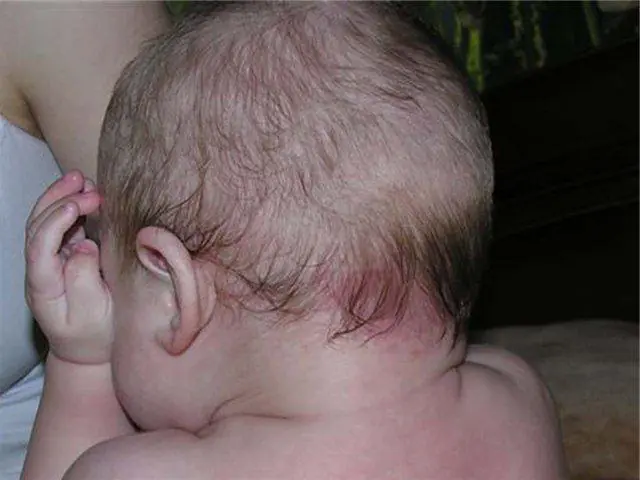It is quite a common occurrence when a newborn child can observe various spots in the form of moles on the body. They may or may not be hereditary. The last reason is quite common.
Birthmark on the back of a newborn's head
The appearance of any neoplasms on the body of a newborn, including a red spot on the back of the head, should alert parents. Despite their harmlessness, at first glance, it is still necessary to consult a pediatrician. What treatment is required depends on the shape of the spots, color and size. You may not need it, and the stains will go away on their own.
The spot on the back of the head is popularly called the “kiss of an angel” or “stork bite”, and in the medical community – nevus of Unna, or telangiectasia. Birthmarks can be of two types - multiple and single (but large in size). Their surface is not convex and smooth. In the future, the spots become smaller in size and pale in color. When a child reaches the age of 1-2 years, formations on the skin may not be observed.
If the spots are red and have a bluish tint, this is a hematoma. It is rarely observed on the occipital part and is accompanied by swelling. They do not pose a danger to the child, because After a couple of days they disappear.
Consultation with a doctor cannot be avoided in case of hemangioma and gngiodysplasia. In the first case, spots are purple, blue or red, gradually increasing in size. With angiodysplasia, the neoplasms are light pink and sometimes purple in color. They may become darker and also enlarge over time.
Why does a newborn have a red spot on the back of his head?
The spot on the back of the baby's head is formed as a result of compression during childbirth (the baby's head is most often exposed to stress). The mother's pelvic bones have a mechanical effect on the sensitive skin of the newborn. As a result, small skin capillaries are deformed, which is why peculiar spots are formed.
How to remove a red spot on the back of a newborn's head?
Usually, doctors recommend monitoring the birthmark, taking measurements of the tumor, as well as photographing them at different time intervals. If they are dangerous for the child, they are usually removed. This is especially necessary if:
- The spot is very large (exceeds 20 cm in diameter).
- A child has over 5 of them on his body.
- The spots increase in size at 6 months of age and older.
- The nevus is localized in a traumatic area, for example, in the folds of the skin.
In other words, every change in a birthmark gives an alarm. For example, if the color has changed from red to dark, or the shape and structure of the formation has changed, the stain is bleeding, etc.
To eliminate a nevus, they often resort to:
- Drug therapy.
- Laser and surgical removal. The latter method is not often used.
- Cryotherapy.
If the doctor insisted on the option of removing the child’s spot, parents should not worry. Modern technologies make such operations safe, fast and absolutely painless. After removing the stain, small scars and cicatrices remain in the area where it is located. They can be removed by a plastic surgeon at any time.
Sometimes it will not be a bad idea to consult with several specialists if the attending physician has prescribed removal of a birthmark. For example, this could be a dermatologist, surgeon or oncologist. The main reason is that doctors are people too, and like any person, they can make mistakes.
To perform the operation, local anesthetics are necessarily used, which can negatively affect the baby. Therefore, if the situation is not too sad, it is better to postpone surgical intervention until the child is older.
Quite often, moles or spots can be seen on the body or head of a newborn baby in the first days after birth. In some cases they are inherited, but most often they are not genetic in origin. Any new growths on the skin, for example, red spots on the back of a newborn’s head, even those that may seem insignificant, require attention from parents and consultation with a pediatrician. And the doctor, based on the color, size, shape and texture of the spots, will be able to make a prediction about how this spot may develop and what treatment may be needed.
How does an angel kiss?
While still in the maternity hospital, attentive mothers discover certain spots on the skin of their beloved little one. It is there that you can and should get your first consultation with a pediatrician about the dangers of “birthmarks” and whether surgical intervention will be necessary.

Such marks on the body, face or back of the head of babies are called “angel kisses” or “stork bites”. Almost everyone knows this. But will they go away on their own or will the baby subsequently pay for the “unkindness” of the children’s postman? How to cure this disease, and is it even a disease? Let's try to figure it all out.
Is nevus of Unna safe?
According to statistics, in 40-50% of cases there is slight redness or even red spots on the back of the newborn’s head. In appearance, these are small numerous spots or one large one. A beautiful legend says that these are traces from the beak of a white stork, which brought the baby to his parents. More pragmatic doctors call these spots telangiectasia, nevus of Unna, or birthmarks.

As a rule, they pose absolutely no danger to the baby’s health. They have characteristics that characterize them: pink or red; flat surface (meaning that the baby’s skin is pigmented, but the spots themselves are smooth, non-convex, and cannot be identified by touch); Over time, the spots become paler and their size decreases. When the baby reaches the age of 1-2 years, the “angel's kiss” may not be visible at all. The exception is when the child screams or cries a lot.
Attention to the back of the head!
Parents should remember that red spots on the back of a newborn’s head are not always harmless “bites” from a beautiful white bird. They can be varieties of a wide variety of skin formations. Therefore, every incomprehensible mark on the skin of a toddler should be treated very carefully and consult a pediatrician.
From the table you can find out the main signs by which parents will be able to distinguish “non-scary” red spots on the back of the head from those that must be shown to the doctor.
Name of formation on baby's skin
Dimensions and shape
“Stork bite”, or nevus of Unna, or birthmark
Usually non-convex, uneven edges
Present at birth, does not increase over time
Favorable, dissolves over time
Blue or red
Rarely occurs on the back of the head, usually accompanied by swelling
Appears during childbirth, but goes away after just a few days
Crimson, blue or red
As a rule, this is a nodular formation that rises above the surface of the baby’s skin
Appears immediately after birth and tends to increase
Doctor's consultation required
From light pink to purple
Quite large flat spots
Present at birth, may darken and increase in size
Doctor's consultation required
Causes of spots
“Stork bites” are usually located on the baby’s skin exactly in the place that was most compressed during childbirth (the newborn’s head often suffers). Their appearance is due to the mechanical effect of the mother’s pelvic bones on the baby’s delicate skin. The result is deformation of the smallest skin capillaries, which subsequently leads to the formation of “bites”.

During childbirth, the fetus may experience oxygen starvation; its blood vessels become more fragile than before and are most often deformed. Some doctors associate the appearance of birthmarks in babies with an inherited predisposition.
What should parents do?
Children usually do not require treatment at all. The baby is growing up, the red and pink spots on the back of his head turn pale and gradually become almost invisible. In 50% of babies, they go away on their own by the age of three. The only thing that parents may worry about is aesthetics. But red spots on the back of a newborn's head can be removed with a laser.

If parents find red spots on the back of their baby’s head, they should do the following:
1. Remember exactly when these “stork bites” appeared (the most harmless situation is when they have been present since birth).
2. Carefully examine each spot: its size, whether it protrudes above the skin, whether it causes anxiety to the baby (for example, it itches).
3. If none of the above is present, then you just need to draw the pediatrician’s attention to them during a routine examination to confirm the harmlessness of the formations.
If the red or pink spots on the back of the baby’s head darken over time or occupy more and more area, you should urgently consult a doctor.
Hemangioma and hematoma: why do they occur?
Hemangioma is a name given to birthmarks on newborn babies. Toddlers are born with clean skin, without any spots. They appear in the first days or weeks after birth. Externally, hemangioma in newborns looks like a small rash or one spot on the baby’s skin. It can be small or occupy a fairly large area. If you look at the statistics, you can understand that hemangioma occurs 4 times more often in girls than in boys. Moreover, girls with fair skin are more susceptible to the formation of such marks. There is another reason why the likelihood of spots appearing in toddlers increases: being born prematurely.

Some doctors believe that hemangioma in newborns appears due to an imbalance that occurs during the mother's pregnancy at the very period when the fetus's circulatory system is formed; due to the fact that labor was quite weak; due to the fact that the birth was premature.
As the baby grows (in the first six months), these spots may increase in size, and then, most likely, disappear on their own. Sometimes a red head in a newborn persists for several years, after which everything goes away completely.
A hematoma in newborns is one of the soft tissue injuries in which blood vessels rupture. Immediately it is bluish-violet, and later it becomes paler, as if fading - pale yellow or greenish. A cavity forms in the tissue into which the clotted blood drains. A hematoma in newborns on the head is characterized by the accumulation of blood between the skin and bones of the baby’s skull. Education in itself is not scary. But if after 10 days the hematoma does not go away, this is already a reason to worry and consult a doctor.
How to treat nevi?
If there is an “angel’s kiss” on the body or head of a newborn baby, do not despair. The first thing parents can do is draw it on tracing paper and monitor whether it grows in size. We must try not to expose the birthmark to ultraviolet rays, because these are benign formations, but unfavorable factors can provoke the appearance of a malignant tumor. It is also necessary to ensure that these spots are not injured by clothing and do not become infected. You need to be constantly in touch with your pediatrician and contact him if you suddenly discover any alarming symptoms.

They can be removed by surgery or by cryotherapy (a chemical compound will be injected into the spot, causing a narrowing of the enlarged cavity of the blood vessel). In some cases, a laser can be used.
Almost all websites dedicated to children and their development have a separate topic - “Red spot on the back of the baby’s head. What to do?".
Indeed, nowadays, in many newborns, a reddish-pink spot can be seen on the scalp in the area of the second cervical vertebra. And this is not a landmark of time, since such spots have been known for a long time and are popularly called “stork bite.” And this is connected with the ancient belief about the goddess Hera, the patroness of mothers, whose symbol is the stork. According to this belief, it is storks that bring babies into families. And as a result of this “transportation,” the child is left with a mark on the back of his head in the form of a speck.
What do doctors say about this? They call these spots either birthmarks, or attribute them to one of the types of hemangiomas (benign tumors of the vascular system, because spots appear in places where the vessels are closest to the skin).
But doctors cannot name the exact reason for their appearance; it remains a sealed secret for them. Scientists have made the assumption that the spot appears as a result of the child passing through the birth canal. But this version is absolutely untenable, since the spot may not appear immediately at birth. Moreover, children born via Caesarean section also have such spots.
Once it appears, the spot may increase in size, may not change at all, or may, over time, completely disappear without any medical intervention, of course. It should be noted that similar spots can be found on other parts of the body. Most of them go away in the first year and a half of a child’s life, with the exception of the spot on the back of the head. Here it can stay for life.
So what is this mysterious mark at the base of the skull? Why does it occur? Does it carry some kind of secret or is it really a structural feature of blood vessels and skin? Or maybe you have this mysterious spot too?
If you want to get answers to these and many other questions about yourself or your loved ones, then turn to the source of amazing and unique knowledge - the books of Anastasia Novykh. You can download all parts from our website completely free of charge! These books will reveal to you not only the secrets of our bodies, but also the energy structure of a person, and teach you how to manage your hidden capabilities using simple, understandable examples.
Read more about this in the books of Anastasia Novykh
And this spot manifests itself due to the work of the energies of the pineal gland. Although, essentially, it does not matter much. This does not mean that a person has achieved anything in this life. It just says that in a past life a person achieved a significant result in spiritual development; he almost deserved to get closer to God, to get out of the circle of reincarnation. In this life he is given a CHANCE: either he will finally win his Armageddon and be freed, or he will lose - then start all over again. Simply put, if a person did not fall for his material essence, which began to dominate him and took him, the little pig, away from the ocean, then he boils in a violent search for spiritual “food”. And developed intuition gives a feeling of an urgent need to search for relevant knowledge. Although knowledge as such, that which people have in mind, does not play a special role in spiritual development. This is just a necessary button of comprehension for strengthening the dominance of the Soul in the empire of one’s own consciousness, for strengthening the inner Faith. Those people who have matured spiritually due to the experience of previous reincarnations, or who simply took care of themselves and wandered from religion to religion, or people who are free in perception, at the right moment simply opened a book and saw the truth or heard the right word. And the person is illuminated, he awakens, as if from the ringing of an alarm clock. That is, a person wakes up and begins to understand that the reality that he perceived as life is actually a dream.
— Anastasia NOVIKH "Sensei I"
Link to the book - Anastasia NOVIKH - AllatRa



